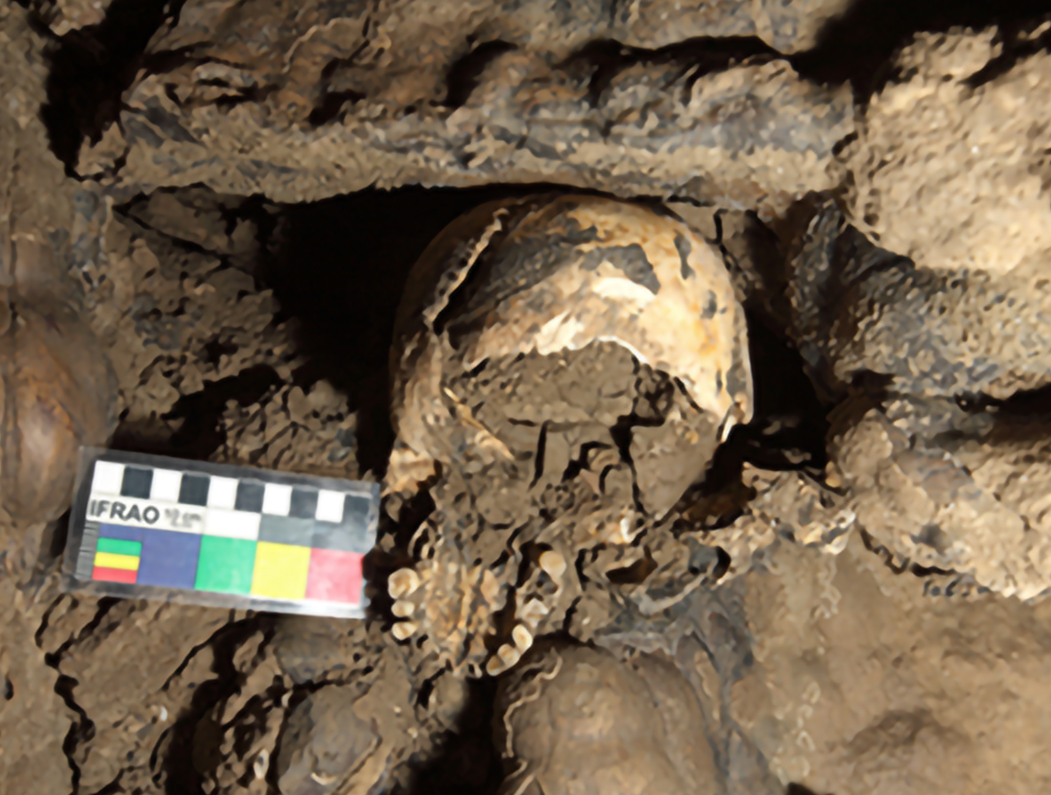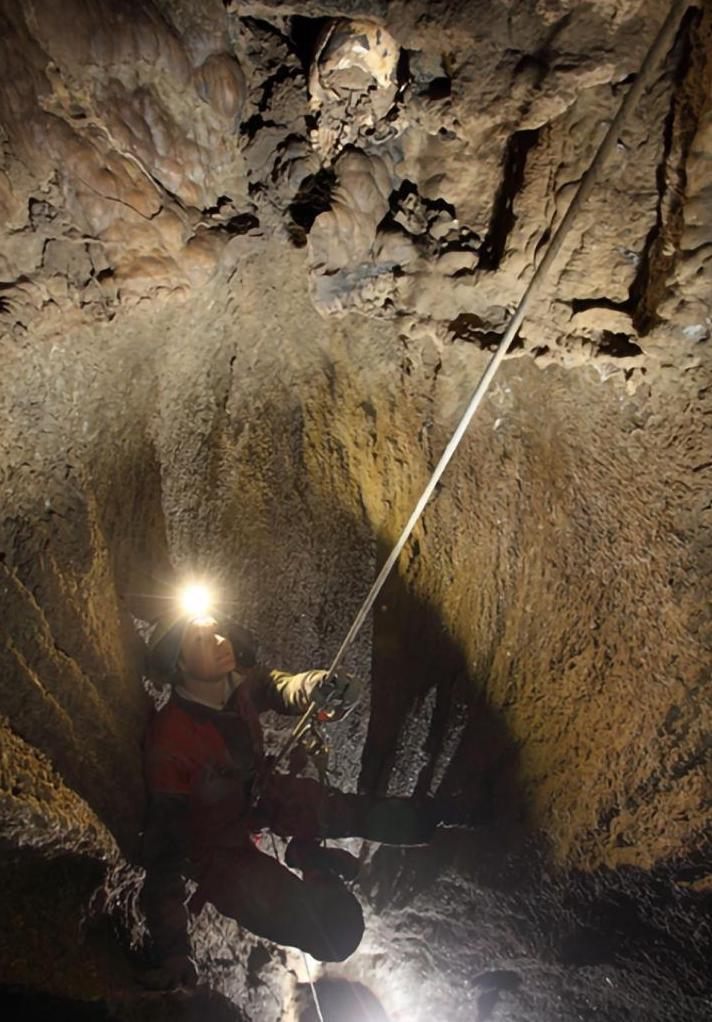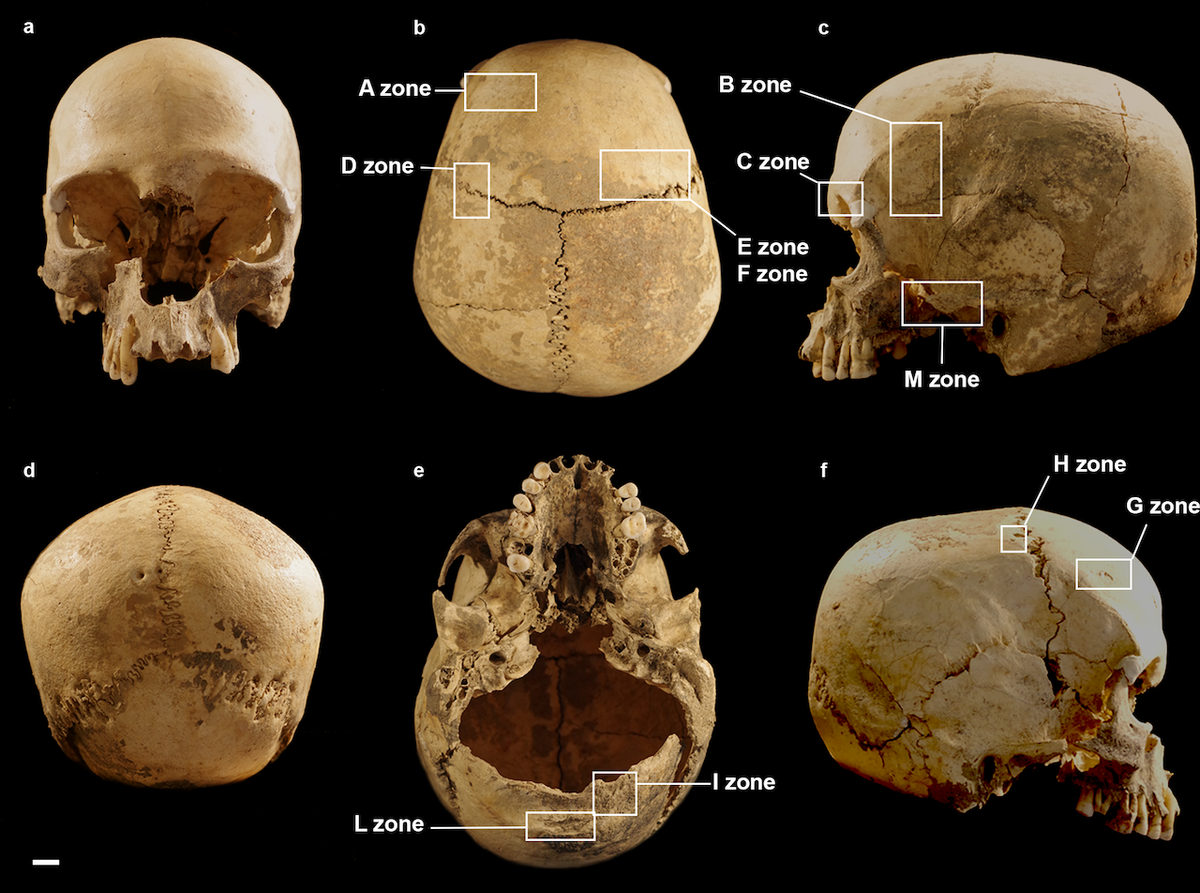Solved: The Mystery of a Lonely Human Skull in an Italian Cave
Scientists found answers in a single piece of evidence.

The find was perplexing. In 2015, cave explorers inching through a vertical passage in northern Italy’s Marcel Loubens Cave discovered a partial human skull. The cranium was missing its jawbone, and sat upended on a slim ledge near the top of the shaft. No other human remains were found there, and there was no sign of who might have placed the skull there, or when, or why.
Marcel Loubens Cave sits near the center of Dolina dell’Inferno, or Hell’s Sinkhole, a massive karst formation riddled with narrow passages carved into the porous rock by water over millennia. The cranium’s location was particularly poignant: The cave is named in memory of the speleology legend Loubens, who died while exploring a system in his native France in 1952. Was the skull the remains of another adventurer who met a tragic fate? The shaft where the remains were found sits within a meander, caver-speak for a winding passage created by an earlier flow of water. This proved to be the first clue to what befell the individual.
In June 2017, a team of about a dozen volunteers, including University of Bologna archaeologist Lucia Castagna, worked their way through the narrow spaces to where the partial skull waited for them, undisturbed since its discovery. The meander leading the team to the skull is about 85 feet underground, and less than a foot wide in places. The difficulty of negotiating its treacherous turns has earned it the name Meandro della cattiveria, or Maze of Malice.
“Even today, with all the modern technical equipment at hand, speleological reconnaissance is still a dangerous matter, which requires lots of respect for nature, and more so for these remote environments where you are essentially on your own,” says Wolfgang Stinnesbeck of Heidelberg University via email. While not involved in the Marcel Loubens Cave research, Stinnesbeck works at the intersection of geology, paleontology, and archaeology, and has analyzed human and animal remains recovered from deep within the flooded coastal cave systems of Quintana Roo, on Mexico’s Yucatán Peninsula.
For researchers who work with human remains in these difficult environments, Stinnesbeck says, concern for the safety of the team is mingled with the realization of what the ancient people they study may have experienced. Stinnesbeck recalls reading Tom Sawyer as a child: “The moment when Tom is lost in the cave and the light extinguishes really took my imagination and I thought, ‘This would be a really bad way to die.’”
Fortunately, no such tragedy befell the team attempting to retrieve the skull from its unusual location in Marcel Loubens Cave. Castagna, an experienced cave explorer, reached the shaft and performed a technical climb of about 40 feet to collect the remains, which were then whisked to the university for analysis. There, a team led by archaeologist Maria Giovanna Belcastro began the work of reconstructing the skull’s story—in life and in death.

“The challenge was to ‘read’ only the cranium … to unveil the fate of the corpse,” says Belcastro. Over the next several months, her team determined the cranium belonged to a woman in her late 20s or early 30s, and that she had died more than 5,000 years ago. Further analysis of the bone showed that she had experienced periods of malnutrition and anemia, but her actual cause of death is unknown.
“Observing the cranium generally, it seemed normal, as many other archaeological human remains,” says Belcastro, adding that more detailed inspection also revealed indentations on the bone formed shortly after the woman died. Her team ruled out scavenging by an animal; rather, the marks were consistent with soft tissues being removed by a human using a sharp tool.
“It was not so surprising to observe those lesions in that skull.… [Such] treatments and manipulation of the corpses and skeletons are largely testified in the prehistory,” she says. Other individuals from this period have been found in Italian caves—just half a mile from the site, for example, archaeologists in the mid-20th century found dozens of artifacts and partial human remains in caves. This cranium, however, was different in a key way. Those other remains were not so deep in the cave system; placing the Marcel Loubens Cave skull where it was found would have required either modern climbing equipment or Spiderman-like skill. So the team’s investigation took a new direction.
“Step by step, we reconstructed the history and the destiny of the corpse of that poor woman,” says Belcastro. Chemical analysis of mineral stains on the bone, and of sediments that had accumulated inside the skull, helped the team build both a timeline and a map of the woman’s journey after death. Their dogged investigation, published recently in PLOS ONE, paid off.

Shortly after her death from unknown causes, the woman’s body was prepared in some way, likely defleshed and dismembered. Separated from the body, the skull appears to have fallen, or been washed into, one of the area’s many sinkholes, possibly during heavy rains or a mudslide. From there, the cranium was carried along by a coursing underground waterway before it got lodged in the shaft. Over more than 5,000 years, continued erosion of the rock around it moved the bone into the position where cavers found it.
Stinnesbeck and his team recently performed a similar investigation on Chan Hol 3 woman, a partial skeleton found near Tulum, Mexico, in a submerged cave system. The remains, almost 10,000 years old, are among the oldest such finds in the Americas. Using methods similar to those employed by the Italian team, the researchers determined that she had survived disease and head trauma before being placed in the cave, which was dry at the time due to lower sea levels.
“In many aspects, [the Marcel Loubens Cave cranium research] resembles our work on the Chan Hol 3 woman,” Stinnesbeck says. “We both tried to shed light on the life and death of these poor individuals. As scientists, we document our data as objectively as possible but, as a human, we are well aware of [their] fate.”
Belcastro agrees, pleased her team was able to solve this very cold case, but, she says, “sad to think the long journey her corpse, or part of her corpse, had until her final and lonely resting place.”


















Follow us on Twitter to get the latest on the world's hidden wonders.
Like us on Facebook to get the latest on the world's hidden wonders.
Follow us on Twitter Like us on Facebook